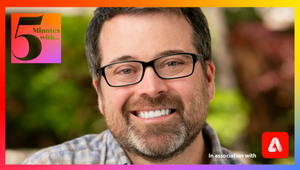
5 Minutes with… Nick Law

Adobe XD is a proud supporter of LBB. Over the upcoming months, as part of the sponsorship of the ‘5 Minutes with…’ channel, we’re spending time with some of the most innovative and creative minds in the industry.
We’re thrilled to get the chance to chat to Nick Law today. Currently the global lead for design and creative technology at Accenture Song, Nick is one of advertising’s most progressive thinkers. He joined Accenture Song in February of this year after a two-and-a-half year stint client-side at Apple. Before that he was the chief creative officer at Publicis Groupe. 20 years ago, Nick joined R/GA and played a key role over 17 years in shaping what became one of the defining advertising agencies of the 2000s.
As mentioned, Nick is presently Accenture Song’s global lead for design and creative tech. LBB’s Addison Capper quizzed him on design and systems thinking, why technology needs creative minds to push it forward, and the ‘fear of the new’ in a fragmented industry.
LBB> To start, I wanted to ask you a few questions about your role and job title. 'Creative tech' is something we, as an editorial team, are making a concerted effort to cover more extensively. But, we sometimes struggle to define 'creative tech'. Maybe you can help us! How do you define that element of your job?
Nick> The most concise description is the creative application of technology. We are in an age where the rapid emergence of new technology creates infinite opportunities. Identifying and translating those opportunities into simple human experiences is a creative task. Typically, emerging technology is the domain of technicians. Early photographers were more chemists than artists. Their concern was fixing an image to a glass plate rather than composing an artful image. Also, the people that develop new technology usually borrow existing creative grammar. Early photography looked a lot like portrait or landscape painting. Early film was just theatre staged in front of a camera. The grammar of camera movement and editing hadn’t been created. The imagination needed to invent techniques that take advantage of new technology comes from creatives – not technicians. So, my role in advancing creative tech is to introduce creative minds to technology early and have them become fluent enough that they can experiment and invent.
LBB> When it comes to the design aspect of your title, design thinking can be applied to many creative disciplines, from very digital mediums to the most analogue. How does that influence what you do?
Nick> Design thinking has become an overused, poorly understood word. At its core, it’s how to solve a problem by imagining something that doesn’t exist through the lens of the people who will use it. Importantly, in this connected age, I would add ‘systems thinking’, understanding how this thing relates to everything else. Of course, none of it matters if you can’t connect design thinking with design making. For me, the theory has always been at the service of practice. Systems thinking is needed for everything Accenture Song does: from designing new business models, innovative products and services that come from those models, and putting compelling stories out in the world.
LBB> What kind of lessons did you learn while client-side at Apple that you might not have picked up while still at an agency or holding company?
Nick> Working client-side is entirely dependent on the company you’re working for, and how they approach marketing and design. Working for a company that has a deep design culture is very different from working for a company that has no understanding or appreciation of creativity. There are similarities. No matter where you are, everyone must work with stakeholders, whether they’re clients or colleagues. And ultimately, the customer is who we’re all working for. And there are differences. In my experience, client-side creatives tend to have a better sense of the product, and agency-side creatives have a broader understanding of culture.
LBB> 'Technology' is such a broad word that can confuse and intimidate people. How important is it for you to ensure that your clients (and maybe creatives too) are clued up enough to make the most of what's at hand?
Nick> I have a simple way of thinking about technology. It’s any medium that brings our ideas to life. You can’t separate creativity from technology. An idea is only creative if it’s ‘created’; and to do that, you need a technology, whether it’s software, broadcast, or a pencil. Our clients and creatives must understand the limitations and opportunities of these mediums. Since the advent of the internet, the proliferation of technology has meant keeping pace and mastering each new opportunity is almost impossible. As a result, we see a lot of examples of old techniques applied to new technology. My job is to get curious creatives working with great technologists to shape new worlds for our clients.
LBB> Is there one piece of technology that's exciting you most right now in your personal life as well as advertising?
Nick> I’m not alone in thinking the sudden emergence of AI image generators is the beginning of a creative revolution. It’s early, and the technology is moving faster than our imagination. Right now, in this partnership between human and machine, it’s the human side that is ill-considered and crude; full of cheap novelty and play rather than mastery. This reality will change as a small group of creative visionaries begin to manipulate the technology with curiosity and craft.
The time between an idea and its materialisation is now close to instantaneous – so we can expect to see an exponential growth in rich content. Since it’s so easy to do (and almost everyone will have access to the technology), most creations will be artless, but the cream will rise to the top and astonish us.
LBB> Looking at R/GA, Apple and now Accenture Song, a lot of your career has been centred around the technological side of creativity. Is that something that you quite consciously carved out for yourself or did things just fall into place? Why is it a space that you enjoy operating in?
Nick> I haven’t consciously thought about technology; I’ve just used what was in front of me. I enjoy any opportunity to be creative.
As I’ve already alluded to, if technology is human inventions that are mediums for our expression, then everything since drawing with a burnt stick is technology. The alphabet is as much a technology as AI. They have different limitations and potentials, but both require the Gladwellian ten thousand hours to master. It’s short-sighted to think that everything that was invented after the stuff you grew up with is ‘technology’.
This fear of the new is particularly prevalent in creative agencies that began to lose touch with their medium in the late ‘80s when media was separated and aggregated to get economies of scale. Because, up until then, all agencies made their money from media commissions – this forced ‘creative’ agencies to start selling ‘ideas’. The problem with creative ideas is that they can only be expressed as ‘creations’, and thus in a medium. And so, the ‘big ideas’ that agencies sell look suspiciously like the last medium they mastered – broadcast. Given the fragmenting of media that followed the emergence of the internet, the timing of this distancing from media and technology couldn’t have been more ruinous.
The trope of introducing an idea in a client presentation as an ‘anthem’, and then extruding the same idea awkwardly into pixels later in the deck has led to an industry earning the scathing prefix ‘traditional’.
The same can be said for design companies that develop brand identity systems that are blind to how they live in interfaces, now their most ubiquitous and meaningful application.
LBB> Excuse the cheesy question, but who or what are your design heroes / favourites?
Nick> Dieter Rams and his modern successor, Jonny Ives. Because they both have clear principles and precise practices, there is a direct line from their thinking to their making. And the result is smart and beautiful.















